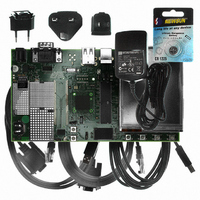AT91SAM9G10-EK Atmel, AT91SAM9G10-EK Datasheet - Page 204

AT91SAM9G10-EK
Manufacturer Part Number
AT91SAM9G10-EK
Description
KIT DEV FOR SAM9G10 ARM
Manufacturer
Atmel
Type
MCUr
Specifications of AT91SAM9G10-EK
Contents
Board, Cables, Power Supply
Silicon Manufacturer
Atmel
Core Architecture
AVR
Kit Contents
Board
Svhc
No SVHC (15-Dec-2010)
Mcu Supported Families
AT91SAM9G10, ARM926EJ-S
Tool / Board Applications
Microcontroller
Rohs Compliant
Yes
For Use With/related Products
*
Lead Free Status / RoHS Status
Contains lead / RoHS non-compliant
- Current page: 204 of 730
- Download datasheet (12Mb)
23.4
23.4.1
6462A–ATARM–03-Jun-09
Product Dependencies
SDRAM Device Initialization
The initialization sequence is generated by software. The SDRAM devices are initialized by the
following sequence:
After initialization, the SDRAM devices are fully functional.
Note:
1. SDRAM features must be set in the configuration register: asynchronous timings (TRC,
2. For mobile SDRAM, temperature-compensated self refresh (TCSR), drive strength
3. The SDRAM memory type must be set in the Memory Device Register.
4. A minimum pause of 200 µs is provided to precede any signal toggle.
5.
6. An All Banks Precharge command is issued to the SDRAM devices. The application
7. Eight auto-refresh (CBR) cycles are provided. The application must set the Mode to 4 in
8. A Mode Register set (MRS) cycle is issued to program the parameters of the SDRAM
9. For mobile SDRAM initialization, an Extended Mode Register set (EMRS) cycle is
10. The application must go into Normal Mode, setting Mode to 0 in the Mode Register and
11. Write the refresh rate into the count field in the SDRAMC Refresh Timer register.
TRAS, etc.), number of columns, rows, CAS latency, and the data bus width.
(DS) and partial array self refresh (PASR) must be set in the Low Power Register.
(1)
1 in the Mode Register and perform a write access to any SDRAM address.
must set Mode to 2 in the Mode Register and perform a write access to any SDRAM
address.
the Mode Register and perform a write access to any SDRAM location eight times.
devices, in particular CAS latency and burst length. The application must set Mode to 3
in the Mode Register and perform a write access to the SDRAM. The write address
must be chosen so that BA[1:0] are set to 0. For example, with a 16-bit 128 MB SDRAM
(12 rows, 9 columns, 4 banks) bank address, the SDRAM write access should be done
at the address 0x20000000.
issued to program the SDRAM parameters (TCSR, PASR, DS). The application must
set Mode to 5 in the Mode Register and perform a write access to the SDRAM. The
write address must be chosen so that BA[1] or BA[0] are set to 1. For example, with a
16-bit 128 MB SDRAM, (12 rows, 9 columns, 4 banks) bank address the SDRAM write
access should be done at the address 0x20800000 or 0x20400000.
performing a write access at any location in the SDRAM.
(Refresh rate = delay between refresh cycles). The SDRAM device requires a refresh
every 15.625 µs or 7.81 µs. With a 100 MHz frequency, the Refresh Timer Counter
Register must be set with the value 1562(15.652 µs x 100 MHz) or 781(7.81 µs x 100
MHz).
A NOP command is issued to the SDRAM devices. The application must set Mode to
1. It is strongly recommended to respect the instructions stated in
cess in order to be certain that the subsequent commands issued by the SDRAMC will be
taken into account.
AT91SAM9G10
Step 5
of the initialization pro-
204
Related parts for AT91SAM9G10-EK
Image
Part Number
Description
Manufacturer
Datasheet
Request
R

Part Number:
Description:
MCU, MPU & DSP Development Tools KICKSTART KIT FOR AT91SAM9 PLUS
Manufacturer:
IAR Systems

Part Number:
Description:
DEV KIT FOR AVR/AVR32
Manufacturer:
Atmel
Datasheet:

Part Number:
Description:
INTERVAL AND WIPE/WASH WIPER CONTROL IC WITH DELAY
Manufacturer:
ATMEL Corporation
Datasheet:

Part Number:
Description:
Low-Voltage Voice-Switched IC for Hands-Free Operation
Manufacturer:
ATMEL Corporation
Datasheet:

Part Number:
Description:
MONOLITHIC INTEGRATED FEATUREPHONE CIRCUIT
Manufacturer:
ATMEL Corporation
Datasheet:

Part Number:
Description:
AM-FM Receiver IC U4255BM-M
Manufacturer:
ATMEL Corporation
Datasheet:

Part Number:
Description:
Monolithic Integrated Feature Phone Circuit
Manufacturer:
ATMEL Corporation
Datasheet:

Part Number:
Description:
Multistandard Video-IF and Quasi Parallel Sound Processing
Manufacturer:
ATMEL Corporation
Datasheet:

Part Number:
Description:
High-performance EE PLD
Manufacturer:
ATMEL Corporation
Datasheet:

Part Number:
Description:
8-bit Flash Microcontroller
Manufacturer:
ATMEL Corporation
Datasheet:

Part Number:
Description:
2-Wire Serial EEPROM
Manufacturer:
ATMEL Corporation
Datasheet:










